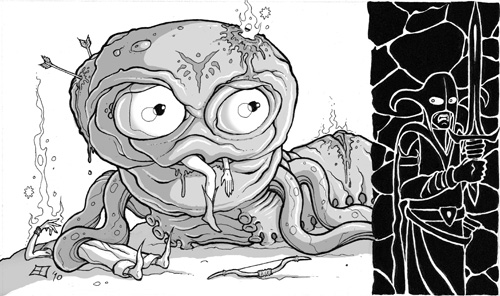One of the objections to the megadungeon concept in the Dungeon Crawl Classics role-playing game is that the source fiction of Appendix N is primarily short stories, and that the DCC rpg works best as a series of short stories in consequence.
Well, there is certainly some truth to the idea that many of the Appendix N authors wrote primarily short fiction, as they were writing for the pulps. Robert E. Howard, for example, wrote primarily short stories. There is only one Conan novel, The Hour of the Dragon, and his planetary adventure novel, Almuric, seems to make up the list of Howard's longer fantasy. Fritz Leiber, of course, wrote short stories that sometimes strung together into longer plots. H.P. Lovecraft and August Derleth were also primarily short story writers. For Lovecraft, At the Mountains of Madness, The Case of Charles Dexter Ward, and The Dream-Quest of Unknown Kadath are notable exceptions. The Lurker at the Threshold was completed by August Derleth from a Lovecraft fragment.
In the case of Manly Wade Wellman, Howard, Lord Dunsany, Lovecraft, or Derleth, one story may very well be disconnected from other stories, even in the same series. It matters little what order Wellman's Hok the Mighty or John the Balladeer stories are read, for instance. In other cases, such as the stories of Gardner Fox or Leiber, the order matters quite a bit, because the stories resolve into larger plots. These are not so much short stories, but serialized novels.
(Manly Wade Wellman went on to write five "John the Balladeer" novels, of which I have managed to obtain The Old Gods Waken and After Dark, the first two. When one compares that to the short stories, which can be collected in a single book, one has to wonder in this case whether it is fair to say Wellman is writing primarily short stories or novels with this character.)
If we examine Appendix N, 22 specific books are recommended and 13 specific series. Of the 22 books, 20 are novels and 2 are collections of short stories. Of the 13 series, 4 may be considered series of short stories, although I would argue that the listed series of Gardner Fox are novels that were published serially, and that the "Fafhrd & Gray Mouser" series by Fritz Leiber in places comes close to being the same.
The megadungeon model does not require that each session revolve around the megadungeon, but merely that it always be part of the background in the event that the players are looking for something to have their PCs do. It is a convenient resource to allow the players to choose their own course - if they absolutely refuse to follow rumours and plot hooks to Hirot, they can choose to explore westward into the Great Ruins of Thereitis.
While many believe that the megadungeon was invented by J.R.R.T.'s vast ruins of Moria, or the halls of Thror under the Lonely Mountain, one can discover vast underground tunnels and ruins in the writing of Edgar Rice Burroughs, Gardner Fox, Robert E. Howard, H.P. Lovecraft, and Margaret St. Clair. Vast ruins (including underground ruins of many levels) also feature in Sterling Lanier's Hiero's Journey.
Like it or not, the vast ruin, and the network of underground tunnels, are as Appendix N as any other aspect of gaming. Likewise, novels are at least as influential as short stories in Appendix N fiction. As a consequence, the megadungeon is an apt fixture in many (but not all) Dungeon Crawl Classics campaigns. It provides a place for the PCs to explore, it allows the players to make meaningful decisions about what quests to undertake, and it gives the judge a place to locate lost civilizations, forbidden magic, and all of that goodness that puts the "dungeon crawl" into "Dungeon Crawl Classics".



Well said.
ReplyDeleteThat would be my ideal use of a megadungeon -- dip into it when you feel like it (rather than the megadungeon being the breadth and width of the campaign).
ReplyDeleteCastle Whiterock fits that bill, too, doesn't it? A big structure with lots to explore, lurking there on the hill, ready to dip into when the players wish to...
I make use of the Barrowmaze in this regard, as well as Stonehell. I intend to adapt the MERP version of Moria as well.
DeleteDoesn't really matter if the dungeon is 3 rooms big or 13 levels... it's the place where adventure happens!
ReplyDeleteI didn't know people were objecting to megadungeons in DCC RPG. Usuaully the "swiss-cheese" factor of megadungeon doesn't jive with more serious games, but it seems right at home in DCC.
ReplyDeleteNot objecting so much as making a claim that a megadungeon or two doesn't fit the genre. I think it does, obviously.
Delete